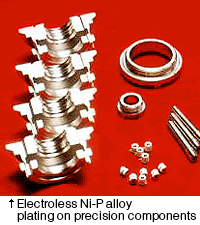HOME > Surface Finishing Tutorial > #144 Electroless Plating, Electroless Nickel Plating - 1
Surface Finishing Tutorial
#144 Electroless Plating, Electroless Nickel Plating - 1
Category : Electroless Plating
December28, 2012
Electroless Plating
| Electroless plating is also called chemical plating. Unlike the electroplating where metal is deposited on objects by reduction precipitation using a DC current, this method uses chemical reduction agents to plate, and therefore does not require DC power sources, cathodes, or anodes. One of such platings is Displacement Plating. It is also called Immersion Plating, and the plating layer is obtained by displacement reaction caused by differential in ionization tendency by simply immersing in the plating solution. Zincate treatment used as a pre-process for aluminum plating belongs to this category. In a case of electroless plating using hypophosphite as the reduction agent, Nickel-Phosphorus (Ni-P) alloy plating is obtained, and Nickel-Boron (Ni-B) alloy plating if boron compounds are used. There are Nickel, Cobalt, Palladium, Copper, Silver, and Gold for electroless platings, though the ones that are put to practical industrial uses are Nickel, Copper, and Gold platings. |  |
Electroless nickel plating -1
Nickel-Phosphorus (2~15%) alloy plating which is a representative of the electroless platings is valued high and utilized in a various application fields due to its excellent mechanical, electrical, and physical properties with its ability to uniformly coat complex shaped components. The properties are shown in [Table] below.
[Table] Physical properties of Nickel-Phosphorus Alloy Plating
|
- Environmental conservation
- Hot Dipping
- Anodic Oxidation Process
- Anodic oxidation treatment
- Anodizing
- Corrosion - Corrosion Protection
- Electroless Plating
- Electroplating
- Heat treating
- Hydrogen embrittlement
- Metal cleaning
- Metal etching
- Painting
- Special paints
- Surface Treatment
- Surface-treated steel sheets
- Thermal Spraying



